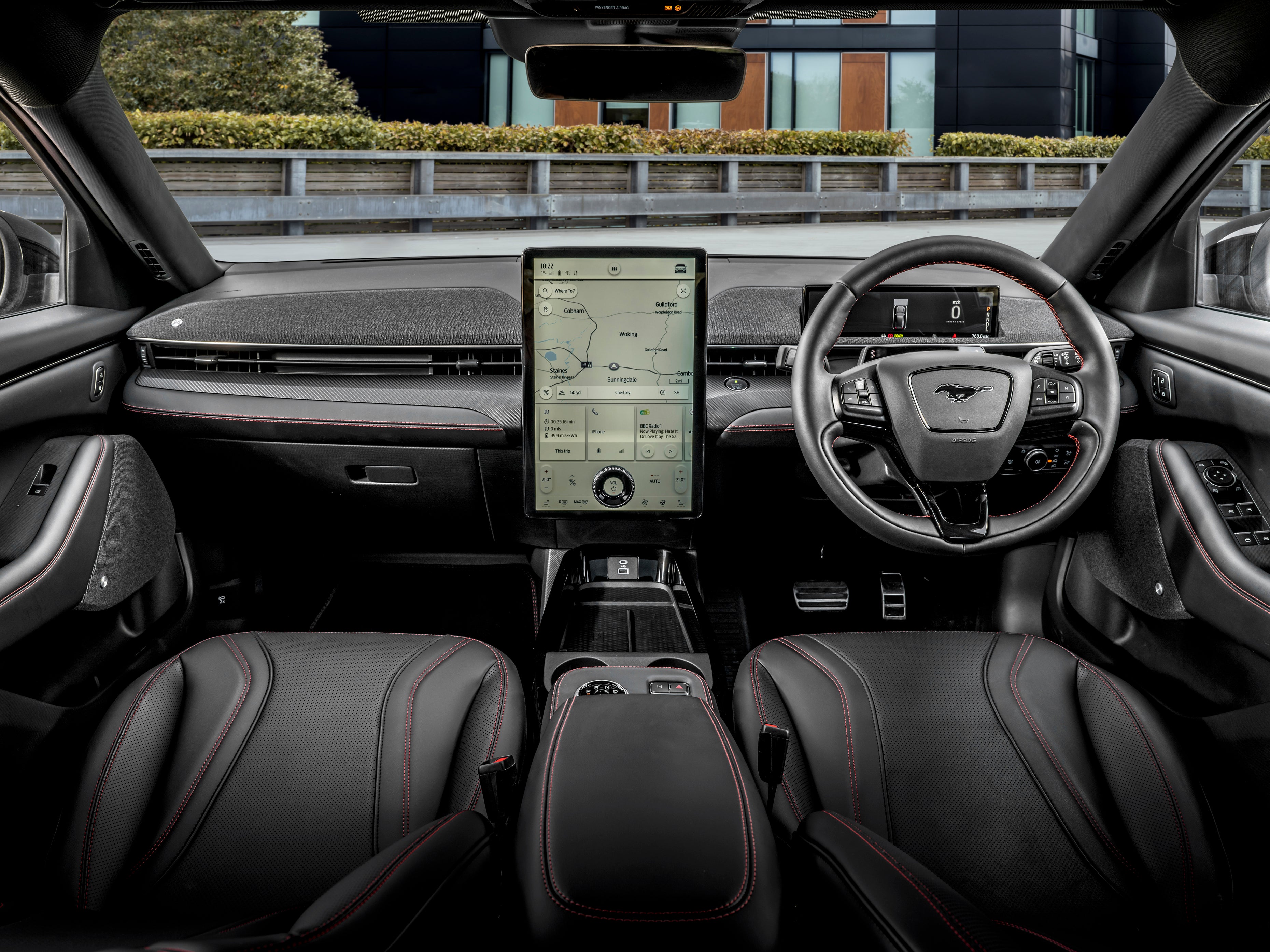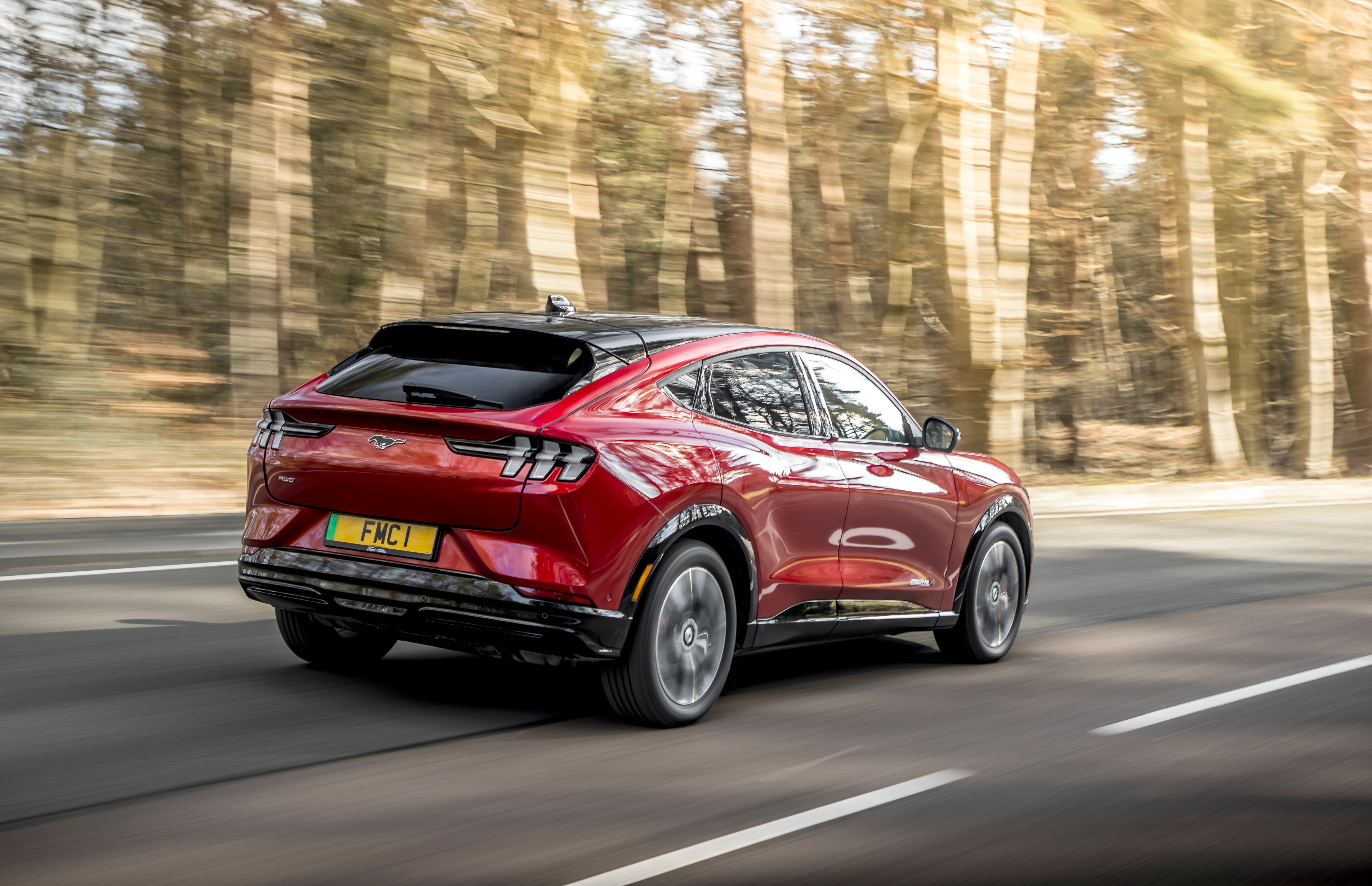Car review: The Ford Mustang Mach-E sits firmly in the middle of the road
Ford’s foray into the electric vehicle market is unremarkable, writes Sean O’Grady – but it’s a signal of intent


When first you meet a Ford Mustang Mach-E you’re forced to ask yourself one of the most fundamental questions about the automobile: how do I get into the darn thing? Unlike old-fashioned metal, Ford’s first proper purpose-built ground-up electric car design does away with archaic door handles and outdated keys. Instead there is a little button you push, and out the front door pops. It has a tiny vestigial handle, like the surround on a Yale front door lock, but it’s not necessary, and is really just there as a reminder of how cars used to be (the rear doors just have the button). The car recognises that you’re the legitimate owner because it senses the presence of the key on your person, and there’s also a discrete touchscreen entry PIN pad for extra security (such as is popular in North America, where the Mach-E will be made and mostly sold). I wonder how durable and reliable the electric mechanism will be, but it’s certainly a talking point when it’s new.
Nor does the fun stop there. Indoors you’re confronted with a conventional set of dials and a comprehensive suite of controls on and around the rather large steering wheel, but also a huge (15.5in) portrait-format tablet-style touchscreen from which you’re supposed to be able to access all the other controls. This is the trendy way of doing things now, especially on futuristic electric vehicles, as pioneered by Tesla (though Tesla has now reverted to landscape orientation), but I’m yet to be convinced of their utility. As ever you find yourself being distracted from the view ahead while fiddling around trying to navigate through the menus to turn the heating up or reprogramme the satnav, say, and I just don’t think it’s that safe really: “eyes on the road” and all that. The Mustang’s set-up is clearer and easier to use than most, notably the one found in its principal rival, the Volkswagen ID.4, but I still prefer buttons and switches.

When you do get the hang of it, preferably when stationary, you can set your driving style according to three optional modes – Whisper, Active and Untamed. These make the car more or less responsive, and also vary the sensory experience. Whisper means you get more regenerative braking, which is good for economy, is deliberately quieter and the interior lighting more muted. Untamed, a ludicrous label, means it doesn’t drive as clunkily, has a conventional car engine soundtrack piped in, and you’ll find you don’t go as far on a charge. Active is somewhere in between. More meaningful options mean opting for different models, with a choice of standard or extended range variants (ie smaller or larger, 88kWh battery packs) and rear- or all-wheel drive, with prices ranging up another £15,000 or so from the base model’s £41,330, and all will get you to 60mph in about six seconds, and all drive pretty well. They feel heavy, because they are all two tonnes-plus, but Ford has done a fine job of getting the handling under control.
My main quibble is the surprising amount of wind and road noise that makes its way into the cabin, though maybe that’s because one notices it more in an EV. All are automatics, with a simple rotary dial between the front seats, do without an old-fashioned handbrake or spare wheel and are well-equipped for comfort and safety. The interior isn’t as lovely as a VW ID.4 or as cool as Polestar 2, or as luxurious as a Mercedes-Benz EQC, say, but it’s good enough. My Ford Mustang Mach-E Standard Range Rear-Wheel Drive test car got me to the national speed limit in as long as it took you to say its name, and offers a class-competitive range (200-270 miles in real-world conditions). An even higher performance GT is on its way, for about £67,000, which is a lot of money for a Ford.

That takes us to another fundamental question: is this a Ford, or what? You can’t help but be struck by the absence of the famous blue oval Ford branding anywhere around the car. Indeed, you’ll only get a fleeting glimpse of it on the touchscreen and on the key fob. On the other hand, the Mustang nameplate and racing pony logo are everywhere (the latter not to be confused with Ferrari’s prancing pony). They’ve even lifted a few design cues from the classic sports coupe, such as the sloping roof (something of an optical illusion achieved by painting part of the back end of this SUV in black), the triple sets of rear lights, and some muscular ridges running down the bonnet as if making space for a burbling V8 (though actually more or less empty).
To me, though, it just reminded me of a bloated Focus, which is no bad thing but by no means a thing of beauty. It certainly beats the hell out of the cumbersome-looking ID.4, but if it’s looks and style you want, then the new Hyundai IONIQ 5 is the most stunning of the present crowd – that is, until the gullwing Tesla Model X turns up. So Ford seem to be wanting to use a different, sporty branding for its new line of electric vehicles, which does seem a bit odd, given that Ford is one of the most venerable and well-known of marques in the business, and Mustang is associated with snarling fossil-fuelled fun. The “Mach” bit is a reference to the speed of sound and a racy derivative of the original Mustang back in the 1960s: the “E” bit stands for electric, I’d imagine. Yet “Mustang” doesn’t summon up the notion of green driving at all. Then again, given that new fossil-fuelled cars will soon be a thing of the past, the Mustang badge won’t be worth much anyway away from legacy accessories, and its brand equity might as well be invested in something that will yield a long-term return. Others are doing something similar – Geely Group/Volvo with Polestar, Stellantis/Peugeot/Fiat with DS, Renault with Alpine, and so on. At any rate, Ford, still a major global player, is disgracefully late to the electric car party. Where once Ford led, in mass production and marketing, now it is playing catch-up.
The Spec
Ford Mustang Mach-E
Price: £41,330
Engine capacity: single electric motor, rear-wheel drive powered by 68kWh battery
Power (PS): 269
Top speed: 111mph
0-60mph: 6.9secs
Fuel economy 163mpg equiv
Range: 215 miles
CO2 emissions: 0
So that’s the newest Mustang, then. An electric cross-over medium-sized SUV that does most things well and nothing badly. It’s less sexy than a Tesla (Model 3, Y or X), has a smaller boot than the VW IQ.4, has a tighter range than the Hyundai IONIQ 5, is about twice as expensive as the bargain electric MG HS, isn’t as eye-catching as the Mercedes EQC, and isn’t as cool as the electric Volvos and Polestars, but at least the Mustang and the Ford Motor Company is in the battery-electric herd, which it wasn’t a year ago, and it’s a signal of intent. Soon enough, Ford will be telling you that you can have any car you like, provided it’s electric and provided it’s called a Mustang, and not a Ford. Fine, but I don’t know what old Henry would have made of it all.
Join our commenting forum
Join thought-provoking conversations, follow other Independent readers and see their replies
Comments
Bookmark popover
Removed from bookmarks